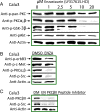Lyn, a Src family kinase, regulates activation of epidermal growth factor receptors in lung adenocarcinoma cells
- PMID: 23866081
- PMCID: PMC3725175
- DOI: 10.1186/1476-4598-12-76
Lyn, a Src family kinase, regulates activation of epidermal growth factor receptors in lung adenocarcinoma cells
Abstract
Background: Activation of receptors for growth factors on lung epithelial cells is essential for transformation into tumor cells, supporting their viability and proliferation. In most lung cancer patients, EGFR is constitutively activated without evidence of mutation. Defining mechanisms for constitutive activation of EGFR could elucidate additional targets for therapy of lung cancers.
Methods: The approach was to identify lung cancer cell lines with constitutively activated EGFR and use systematic selection of inhibitors to evaluate their effects on specific EGFR phosphorylations and downstream signaling pathways. Interactions between receptors, kinases, and scaffolding proteins were investigated by co-immunoprecipitation plus Western blotting.
Results: The results revealed a dependence on Src family of tyrosine kinases for downstream signaling and cell growth. Lyn, a Src family kinase functional in normal and malignant B-lymphocytes, was a defining signal transducer required for EGFR signaling in Calu3 cell line. Src family kinase activation in turn, was dependent on PKCßII. Lyn and PKC exist in membrane complexes of RACK1 and in association with EGFR which pairs with other receptor partners. Silencing of Lyn expression with interfering siRNA decreased EGFR activation and cell viability.
Conclusions: The importance of Src family kinases and PKCßII in the initiation of the EGFR signaling pathway in lung tumor cells was demonstrated. We conclude that phosphorylation of EGFR is mediated through PKCßII regulation of Lyn activation, and occurs in association with RACK1 and Cbp/PAG proteins. We suggest that protein complexes in cell membranes, including lipid rafts, may serve as novel targets for combination therapies with EGFR and Src Family Kinase inhibitors in lung cancer.
Figures







Similar articles
-
PGE2/EP3/SRC signaling induces EGFR nuclear translocation and growth through EGFR ligands release in lung adenocarcinoma cells.Oncotarget. 2017 May 9;8(19):31270-31287. doi: 10.18632/oncotarget.16116. Oncotarget. 2017. PMID: 28415726 Free PMC article.
-
Src family kinases mediate epidermal growth factor receptor signaling from lipid rafts in breast cancer cells.Cancer Biol Ther. 2011 Oct 15;12(8):718-26. doi: 10.4161/cbt.12.8.16907. Epub 2011 Oct 15. Cancer Biol Ther. 2011. PMID: 21775822 Free PMC article.
-
Cigarette smoke induces aberrant EGF receptor activation that mediates lung cancer development and resistance to tyrosine kinase inhibitors.Mol Cancer Ther. 2012 Apr;11(4):795-804. doi: 10.1158/1535-7163.MCT-11-0698. Epub 2012 Feb 1. Mol Cancer Ther. 2012. PMID: 22302097 Free PMC article.
-
Cellular functions regulated by phosphorylation of EGFR on Tyr845.Int J Mol Sci. 2013 May 23;14(6):10761-90. doi: 10.3390/ijms140610761. Int J Mol Sci. 2013. PMID: 23702846 Free PMC article. Review.
-
Novel regulation and function of Src tyrosine kinase.Cell Mol Life Sci. 2002 Mar;59(3):456-62. doi: 10.1007/s00018-002-8438-2. Cell Mol Life Sci. 2002. PMID: 11964124 Free PMC article. Review.
Cited by
-
LYN, a Key Gene From Bioinformatics Analysis, Contributes to Development and Progression of Esophageal Adenocarcinoma.Med Sci Monit Basic Res. 2015 Dec 21;21:253-61. doi: 10.12659/MSMBR.895463. Med Sci Monit Basic Res. 2015. PMID: 26708841 Free PMC article.
-
RACK1 Silencing Induces Cell Apoptosis and Inhibits Cell Proliferation in Hepatocellular Carcinoma MHCC97-H Cells.Pathol Oncol Res. 2018 Jan;24(1):101-107. doi: 10.1007/s12253-017-0214-6. Epub 2017 Apr 10. Pathol Oncol Res. 2018. PMID: 28396991
-
Chronic Cigarette Smoke Mediated Global Changes in Lung Mucoepidermoid Cells: A Phosphoproteomic Analysis.OMICS. 2017 Aug;21(8):474-487. doi: 10.1089/omi.2017.0090. OMICS. 2017. PMID: 28816646 Free PMC article.
-
DriverMP enables improved identification of cancer driver genes.Gigascience. 2022 Dec 28;12:giad106. doi: 10.1093/gigascience/giad106. Epub 2023 Dec 13. Gigascience. 2022. PMID: 38091511 Free PMC article.
-
Decoding sunitinib resistance in ccRCC: Metabolic-reprogramming-induced ABAT and GABAergic system shifts.iScience. 2024 Jun 28;27(7):110415. doi: 10.1016/j.isci.2024.110415. eCollection 2024 Jul 19. iScience. 2024. PMID: 39100925 Free PMC article.
References
-
- Hirsch FR, Varella-Garcia M, Bunn PA Jr, Di Maria MV, Veve R, Bremmes RM, Baron AE, Zeng C, Franklin WA. Epidermal growth factor receptor in non-small-cell lung carcinomas: correlation between gene copy number and protein expression and impact on prognosis. J Clin Oncol. 2003;21(20):3798–3807. doi: 10.1200/JCO.2003.11.069. - DOI - PubMed
-
- Kanematsu T, Yano S, Uehara H, Bando Y, Sone S. Phosphorylation, but not overexpression, of epidermal growth factor receptor is associated with poor prognosis of non-small cell lung cancer patients. Oncol Res. 2003;13(5):289–298. - PubMed
-
- Sebastian S, Settleman J, Reshkin SJ, Azzariti A, Bellizzi A, Paradiso A. The complexity of targeting EGFR signalling in cancer: from expression to turnover. Biochim Biophys Acta. 2006;1766(1):120–139. - PubMed
Publication types
MeSH terms
Substances
LinkOut - more resources
Full Text Sources
Other Literature Sources
Medical
Molecular Biology Databases
Research Materials
Miscellaneous

